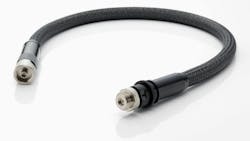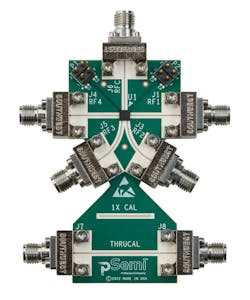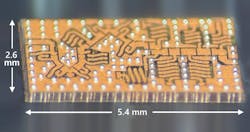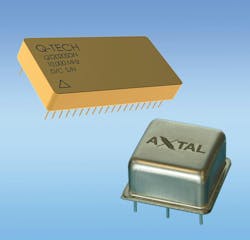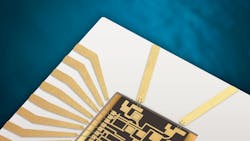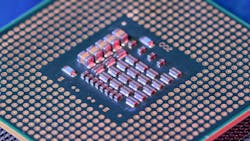Browse our complete IMS 2024 coverage.
Here, we offer roundups of coverage from the 2024 edition of the International Microwave Symposium (IMS) in Washington, D.C. This is Part 2 of 4.
Visit Junkosha (Booth 848) at IMS to see its metrology-grade MWX871 cable, designed for applications such as vector network analyzer (VNA) calibration tests at frequencies up to 70 GHz. Alongside this latest product, Junkosha will feature its ultra-phase stable cable lineup designed to meet the higher frequency demands of tomorrow’s 5G/6G networks.
The industry’s transition to higher frequencies has spawned demand for mmWave-compatible cables. Depending on effects of degradation and a given cable’s characteristics, the cable’s parameters with respect to signal amplitude and frequency can change when the cable is bent, leading to measurement errors and decreased stability.
To meet these challenges, Junkosha’s microwave/mmWave VNA test cable offers exceptional phase (within ±8.9°) and amplitude (within ±0.10 dB) stability during flexure, along with robust phase stability and phase-return characteristics in varying temperatures. Equipped with a ruggedized port-side NMD connector for reliable and robust connections to the VNA, this new cable holds up to the most demanding testing environments.
In IMS Booth 1351, pSemi Corp. will display its new PE42548 SP4T RF switch, a packaged device that's an alternative to traditional flip-chip devices. It meets the growing demand for contract manufacturing-friendly devices, especially in test and measurement applications.
![]() The PE42548 is a HaRP technology-enhanced reflective switch that supports a wideband frequency range from 9 kHz to 30 GHz. It delivers a low insertion loss of 2.0 dB at 26 GHz, rapid switching time of 60 ns, high power handling of 33 dBm, and exceptional isolation performance of 41 dB. As a result, it’s a good candidate for applications including T&M, 5G mmWave, microwave backhaul, radar, and satellite communications. The device fares well in extreme environments with a temperature range of -40 to 105°C, and is housed in a compact 20-lead, 3- × 3-mm LGA package.
The PE42548 is a HaRP technology-enhanced reflective switch that supports a wideband frequency range from 9 kHz to 30 GHz. It delivers a low insertion loss of 2.0 dB at 26 GHz, rapid switching time of 60 ns, high power handling of 33 dBm, and exceptional isolation performance of 41 dB. As a result, it’s a good candidate for applications including T&M, 5G mmWave, microwave backhaul, radar, and satellite communications. The device fares well in extreme environments with a temperature range of -40 to 105°C, and is housed in a compact 20-lead, 3- × 3-mm LGA package.
Spectrum Control (Booth 208) is debuting a new family of surface-mount, BGA RF filters that span 500 MHz to 10 GHz. This family of high-Q, anti-aliasing filters, developed in cooperation with 3D Glass Solutions, is manufactured at wafer scale on glass substrates. The devices measure just 2.6 × 5.4 mm.
The family includes filters for low-pass, high-pass, and bandpass applications with custom filters available for anywhere within the family’s frequency range. Within the standard range, a standout is a 4-GHz IF filter (model MMG-4000-2000-B) with a passband from 3 to 5 GHz. Mid-band insertion loss is 2.2 dB with group delay of 0.8 ns from -55°C to 125°C. The device offers stop-band suppression of more than 60 dBc from DC to 2.5 GHz and 5.8 GHz to 15 GHz
This new family represents a foundational building block for Spectrum Controls’ SCi Blocks range of RF and digital functional blocks, which can streamline the integration of functions into digital defense systems. Platform elements include SiPs, RF-on-mezzanine, and SOSA-aligned 3U OpenVPX modules.
Visit Q-Tech Corp. at IMS (Booth 2223) to see its high-stability microprocessor compensated (MCXO) and oven-controlled (OCXO) crystal oscillators designed to meet critical radiation tolerance specifications for reliable operation in New Space (low earth orbit or LEO) satellite timing and frequency generation applications.
Q-Tech's QT2021 Series of MCXOs and the AXIOM75Sx Series of OCXOs offer a wide range of standard frequencies; the QT2021 MCXOs from 10MHz to 100MHz and the AXIOM 75Sx OCXOs from 10MHz to 400MHz. All are available with either Sine Wave or CMOS logic outputs.
Exxelia (Booth 2108) is showing its main RF/microwave capacitor ranges: Super High-Q & High-Power High-Q CP/CL series and its range of microwave ferrites, including a pre-launch of a High-Epsilon microwave ferrite material.
Exxelia's booth displays will feature its Super High-Q series of RF ceramic capacitors. These capacitors offer ultra-low ESR and can operate at up to 1500 V. They come in sizes from 0402 to 1210 and in capacitance values from 0.1 to 1000 pF. They're suited for advanced RF applications such as power amplifiers, mixers, filters, and matching networks.
The company’s High-Power High-Q series is designed for lower-frequency applications with power handling up to 7200 V and capacitance value up to 10 nF. These capacitors are available in NPO and P90 dielectrics and deliver low ESR and ESL. The CP (P90) and CL (NP0) series serve applications like defense communications (VHF/UHF), medical MR body coils, and RF generators for plasma, semiconductor manufacturing, and extreme ultraviolet (EuV) lithography.
Exxelia will also exhibit its comprehensive range of materials and tuning components, with a special focus on high-performance microwave ferrite products. It will pre-launch a new high-epsilon microwave ferrite. This material features permittivity of 21 and is available in two versions (YK21 and DK21) to address all power applications. It's designed to enhance the performance of high-frequency radar systems, especially in active electronically scanned array (AESA) radar applications. The device's magnetic properties and stability are crucial for the optimal performance of isolator and circulator devices.
In StratEdge's Booth 515, visitors to IMS 2024 can see the company’s range of packages for high-frequency, high-power, and high-reliability semiconductor applications. Purpose-built for microwave, mmWave, and high-power devices, the post-fired and molded ceramic packages operate from DC to >63 GHz. They efficiently disperse heat from GaN, GaAs, and SiC devices.
These packages enable compound semiconductor devices to meet the critical requirements of markets such as telecom, mixed signal, VSAT, broadband wireless, satellite, military, test and measurement, automotive, and down-hole.
In space or defense applications, the packages can be manufactured with thermally enhanced metal bases that ensure efficient heat dissipation. The post-fired ceramic packages feature electrical transition designs that minimize losses.
At IMS Booth 1156, Element Six (E6) is making waves with the work it’s done in partnership with Orbray on synthetic diamond substrates. The pair has announced what it claims as the world’s highest-quality wafer-scale, single-crystal synthetic diamond. Such materials offer high breakdown fields and thermal conductivity, making them a strong contender for future applications in 6G wireless components, advanced power and RF electronics, sensing, thermal management, and quantum devices.
E6’s contribution is in a chemical vapor deposition (CVD) platform that supports large-area, uniform polycrystalline diamond growth up to 150 mm in diameter. The company has recently opened a world-class CVD facility in Gresham, OR. For its part, Orbray has pioneered a heteroepitaxial process to grow single-crystal diamond on cost-efficient sapphire substrates.

